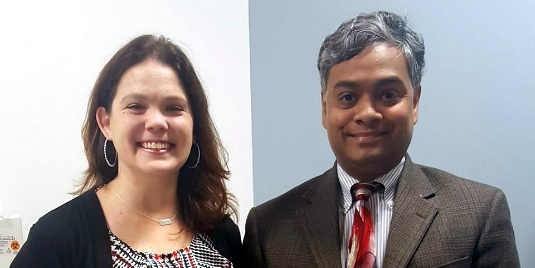Thoracic Outlet Syndrome Patient Christina Landsman

When Christina Landsman pulled into a parking garage at the University of Maryland Medical Center (UMMC) in the spring of 2015, she was ready to give up.
For the last year and half, she regularly experienced pain and numbness in her arms and hands. Tests were inconclusive. Physical therapy was futile. No progress towards a solution was made.
Finally, a diagnosis came. Christina had thoracic outlet syndrome, a rare condition which restricts blood flow to the upper extremities and the brain. Before meeting with Dr. Rajabrata Sarkar, she thought she was at a dead end.
"I said ‘this is the end of the road,’” Landsman told herself as she parked before her appointment. “If he can’t help me, I have to figure out how to live like this.”
Dr. Sarkar, UMMC’s Chief of Vascular Surgery, told her what no one had yet: he thought he could help her. And he did.
Two weeks after their initial meeting, Landsman was in for surgery with Dr. Sarkar, a surgery which helped her regain a normal, active life.
Before surgery and intense physical therapy, the pain affected everything Christina Landsman did.
She couldn’t lift her arms above her head, forcing her to find creative ways to perform normal tasks like blow drying her hair, which she would do upside down. Playing catch with her son was out of the question unless she was prepared to curl up in bed at the end of the day, crying in pain all night. She couldn’t turn her head, making it difficult to drive, among other things.
But when she all of a sudden had trouble sounding out words while helping her son learn to read, she knew something was terribly wrong.
"I got to the word ‘read’ and I went ‘ree-add, ree-add… read!’ I had to sound it out,” Christina said. “Then it was ‘sign’ and I said ‘sing… sing… sign!’ I thought to myself, ‘something is wrong here.’ That, in addition to the pain, really threw me for a loop.”
The biggest issue: no doctor could tell her what was wrong, either.
After X-Rays, brain MRIs, spine MRIs, vascular ultrasounds and several other painful neurological tests, it was finally confirmed that Landsman had an extra rib (cervical ribs) causing thoracic outlet syndrome, the compression of blood vessels or nerves in the space between your collarbone and the first rib. It’s a rare condition, one surgeons typically don’t have experience treating.
Her orthopedic doctor suggested that physical therapy could help. By strengthening her muscles in her shoulder, she could potentially alleviate the pressure and allow blood to flow more easily. After four months of physical therapy, there was no progress. Her next steps were either to go to a pain management clinic or surgery.
A single parent working one full-time job and two part-time jobs, taking pain medicines weren’t even a consideration for Christina. Surgery was her last hope.
Christina posted on Facebook asking for suggestions for a vascular surgeon. Christina’s high school friend Adam Weltz, then a fellow at R Adams Cowley Shock Trauma Center, sent her a message suggesting she take a look at Dr. Sarkar.
After that first meeting, she knew she’d found her guy.
"Dr. Sarkar is amazing,” Christina said. “He’s one of the most personable and humble people I’ve ever met in my life.”
Surgery lasted about four hours and Christina was in the hospital three days before she went home.
Physical therapy followed, and Christina said that was the hardest part. For about five months, she’d go to physical therapy sessions multiple times a week, fighting through excruciating pain while regaining her full range of motion.
And it was more than worth it.
“My son and I, we play catch all the time now,” Christina said. “I can go to his games, I can cheer and I can throw up my arms and yell at the umpire. … I can’t imagine not having that surgery because without it, I can’t even begin to say what my life would be like now.”
